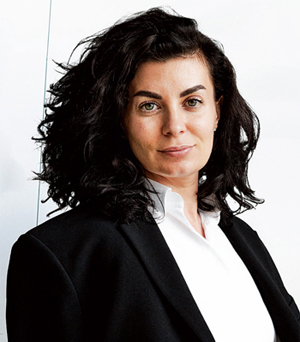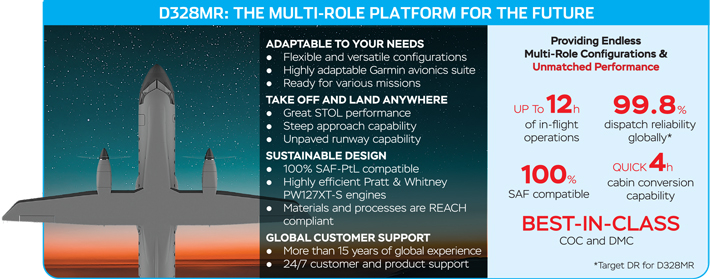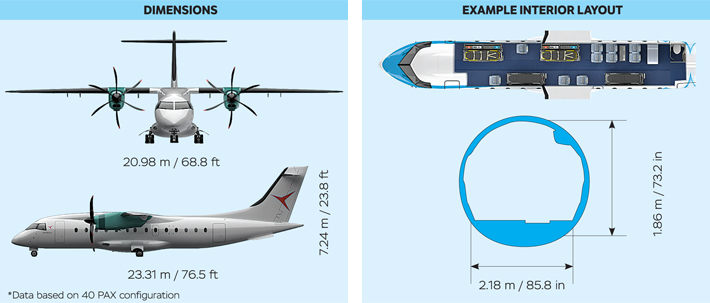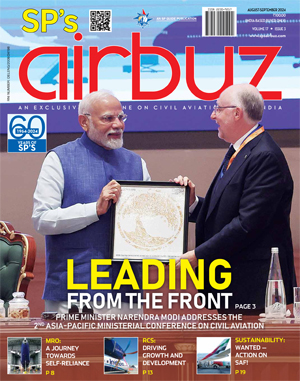EXCLUSIVE
Innovating Air Travel for Tomorrow’s Skies
Deutsche Aircraft, headquartered in Germany, is leading the way to more sustainable flying as part of a future of integrated regional transportation solutions. In an interview to Jayant Baranwal, Editor-in-Chief of SP’s AirBuz, Anastasija Visnakova, Vice President of Sales & Marketing at Deutsche Aircraft, traces the journey of the company and explores its sustainable path forward


Marketing at Deutsche Aircraft
Jayant Baranwal (Jayant): Hello Anastasija, thank you for joining us today. Can you provide us with a brief background of Deutsche Aircraft and your journey since its inception?
Anastasija Visnakova (Anastasija): Certainly, Jayant. Deutsche Aircraft’s roots can be traced back to the renowned heritage of Dornier. Our current in-service legacy D328 JET and Turboprop aircraft are driving innovation for the new regional turboprop D328eco, which stands as one of the most versatile near climateneutral aircraft in the market. We are innovating regional aviation with a more sustainable approach for more integrated transport solutions in any region across the globe.
I joined Deutsche Aircraft as Vice President in Sales and Marketing two years after its inception. Since then, we’ve been actively engaged in sales activities, targeting regions and markets where we can make a significant difference with our innovative approach and the D328eco.
Jayant: That’s fascinating. Now, could you share some details about your complete family of aircraft?
Anastasija: Absolutely. As Deutsche Aircraft, we’re focused on building the D328eco, the next generation of the Dornier 328 turboprop. Here are some key facts about our new platform: it accommodates 40 passengers, boasts 800m STOL capabilities with a 70 per cent load factor, and offers a long-range speed of 324KTAS.
Compared to the in-service Dornier 328 Turboprop, the D328eco provides 14 per cent fuel savings per passenger and reduces up to 50 per cent direct maintenance costs per flight hour.
The new PW127XT-S engine brings remarkable improvements to the D328eco. With 40 per cent longer time on wing, operators can enjoy extended operational hours before maintenance intervals, ensuring greater efficiency and reliability. Additionally, there’s a 20 per cent reduction in maintenance costs, requiring only two shop visits within the first 10 years of service. Plus, a 3 per cent less fuel burn, this not only streamlines operations but also minimises downtime and expenses.

Furthermore, the D328eco stands as a versatile aircraft platform, adaptable to a wide array of multi-role missions. Whether it’s air ambulance services for medical evacuations, regional commuter flights, search and rescue operations, aerial firefighting missions, or maritime surveillance tasks, the D328eco excels. Its flexibility and capabilities make it an ideal choice for various specialised roles, catering to diverse operational needs.
Moreover, the D328eco platform isn’t limited to just specialised missions; it’s also well-suited for corporate and business aviation.
Jayant: Impressive indeed. Now, let’s talk about sustainability. How do you claim that D328eco is the future of zero emissions, and what are its key features in this regard?
Anastasija: The D328eco will be manufactured in an innovative and climate-friendly CO2-neutral final assembly line, powered by renewable and solar energy. It will run on 100 per cent sustainable aviation fuel (SAF) and power-to-liquids (PtL) compatible fuels, offering a pathway towards reducing emissions. Power-to-Liquids can be produced from renewable sources and can replace conventional jet fuel, utilising existing infrastructure at airports. Our ambition is to maximise environmental benefits by flying on 100 per cent PtL with zero aromatics, potentially reducing the climate effects of contrails.
Jayant: Thank you for elaborating on that. Now, from your perspective, how would you define “Regional” aircraft, and what role do they play?
Anastasija: Regional aircraft are essential for connecting local economies that lack proper infrastructure. They enable transportation integration, reaching even the most remote places under rugged conditions. Typically seating up to 50 passengers, these aircraft are lifelines for many communities, fostering economic growth and connectivity.
Jayant: Interesting. Can we presume D328eco will not only serve the commercial airlines around the world but also various business aircraft operators too? Do you offer any unique composition of travel to potential business aviation travellers?
Anastasija: It is a very good question and a legitimate one. The D328eco can be configured to any purpose from commercial passenger aircraft to multi-role operations. There are the multi-role variants of the D328eco which can be configured from cargo carrier to search and rescue. The cabin of the D328eco is versatile to serve any purpose so business aviation is also at the core of what our product can offer.
“Our new regional turboprop D328eco stands as one of the most versatile near climateneutral aircraft in the market.”
The fleet of the up to 50 seat Turboprop is globally ageing. Most of the aircraft currently are used for regional passenger flights. The D328eco is the perfect tool to increase profits by replacing old aircraft. Here we do see a strong demand, but also additional demand in growing markets like the APAC region.
Jayant: Thank you for clarifying that. Now, about the choice of propulsion systems, why did you opt for a turboprop, and how does it cater to different operator preferences?
Anastasija: The reason is quite simple: this is the most efficient and sustainable propulsion system available on the market. And on top of that, it offers outstanding climb and ceiling performance, at 30,000 feet excellent STOL performance without compromising on speed. The D328eco will be the fastest Turboprop in its class.
In consequence we do see more market interest in the turboprop which address their needs to their current operational needs.
Jayant: There’s one basic difference between the Turboprop and the Jet, if I can say, one goes within the weather, flies within the weather, the other, the Jet flies above the weather. Is that correct? Does it apply to your aircraft also?
Anastasija: Indeed, that’s a very good question. Our aircraft is certified to a 30,000 feet ceiling, allowing it to fly above weather, as you rightly said. This sets it apart in terms of performance, boasting outstanding capabilities. Additionally, it features a fully-pressurised cabin equipped with oxygen masks for passengers. So, while it may not adhere to the conventional image of a turboprop, it operates above the weather, which enhances its eco-performance. This makes it particularly suitable for regions with mountainous terrain. The aircraft was designed with global operability in mind, ensuring it can operate effectively in diverse environments. So, as I said the performance of the aircraft is outstanding and really stands out.
Jayant: I’ve heard that one big advantage of the Turboprop is its efficiency compared to a Jet. Is that true?
Anastasija: Absolutely. I fully agree with you. Turboprops, including ours, offer significant efficiency advantages over jets. They consume much less fuel, which not only reduces costs but also enhances sustainability. This is a considerable asset and gives turboprops a distinct advantage in various operational scenarios.
Jayant: Would you share some details on 328 support services? Since time is the paramount factor in flawless operations of the aircraft, can you tell us how effectively the solution/supply of any part/ any repair is handled around the globe? What is the cut-off timing to expedite the response to your operators for their after-sales service/ repair calls?
Anastasija: At Deutsche Aircraft, we have extensive experience with Dornier aircraft, offering comprehensive services for the D328 series, including major modifications and upgrades. We continue to serve our current operators under the same name, ensuring continuity and reliability.
We have evolved from the 328 Support Services GmbH (328SSG) and we still have the Type Certificate (TC) rights for the Dornier 328 platform (D328).

As the TC holder of the D328, we continue to serve in-service fleet for continuity, supporting the global fleet of around 150 inservice D328 aircraft. The team’s daily operations encompass customer & technical support, including design engineering and training to ensure the aircraft remains ahead of its class.
Deutsche Aircraft also strong collaboration with Simulator Training Solution GmbH (STS) to provide training for current D328 operators as part of supporting continuous operation of in-service fleet.
Jayant: That sounds like a robust support system. Now, why do you call Deutsche Aircraft a premium aircraft producer?
Anastasija: Deutsche Aircraft stands out as a premium aircraft producer due to our commitment to excellence and sustainability. We’re building the D328eco in a carbon-neutral final assembly line and offering top-quality services to our customers. Moreover, our partnerships with organisations like the German Aerospace Centre underscore our dedication to driving innovations for climate-neutral flights in 2050. Our German heritage from Dornier further enhances our reputation as a leader in clean energy aviation.
“The D328eco will be manufactured in an innovative and climate-friendly CO2-neutral final assembly line, powered by renewable and solar energy.”
We take great pride in our work, drawing upon our rich heritage in aircraft manufacturing to distinguish ourselves through our D328eco product. Our aim is to be acknowledged as pioneers in innovation, clean energy, and product excellence and our vision extends to leading the charge in sustainable aviation, thereby fostering the advancement of more comprehensive regional transportation solutions.
Jayant: Impressive accolades indeed. Now, in a rapidly evolving aviation landscape, how do you position your aircraft amidst other innovations like electric/hybrid platforms and eVTOLs?
Anastasija: Our R+T team diligently monitors and tests new disruptive propulsion technologies, such as electric/hybrid aviation platforms, with a focus on assessing their potential value for our customers. The development of the D328eco is the direct outcome of this thorough evaluation process.
Our market targeting strategy revolves around identifying regions where integrated regional mobility can be achieved without substantial infrastructure investments. Our goal is to offer an adaptable aircraft solution tailored to the unique demands of each market.

Additionally, we aim to empower operators worldwide to contribute to environmental preservation by utilising Sustainable Aviation Fuel (SAF) and Power-to-Liquid (PtL) technologies whenever feasible.
Beyond the D328eco, we’ve embarked on a partnership with the German Aerospace Agency (DLR) to transform a D328 into a flying testbed. This collaborative effort seeks to explore future propulsion technologies for the benefit of the entire industry.
Jayant: That’s forward-looking indeed. Finally, what are your key market targets globally?
Anastasija: We’re not confined to specific regions; our target markets encompass regional connections worldwide in the up to 50-seater segment. We aim to serve diverse markets with our versatile aircraft platform.
Certainly, having gained experience across various facets of aviation, I possess a comprehensive understanding of both airline operations and Original Equipment Manufacturer (OEM) dynamics. From a commercial standpoint, airlines typically choose their fleets based on operational efficiency. To be part of a company offering a product like the D328eco, the next-generation turboprop, presents a unique opportunity. This aircraft is not only highly efficient but also designed to be 100 per cent compatible with sustainable aviation fuel (SAF) and Power-to-Liquid (PtL) synthetically produced liquid hydrocarbon. This aspect motivates me to advocate for a product that has the potential to significantly advance the industry towards achieving near climate-neutral objectives.
Jayant: Thank you, Anastasija, for sharing your insights with us today. Your commitment to sustainability and innovation is truly commendable. We wish Deutsche Aircraft continued success in its endeavours.





